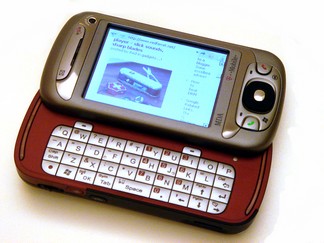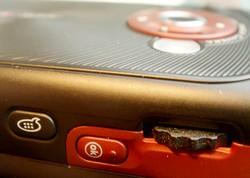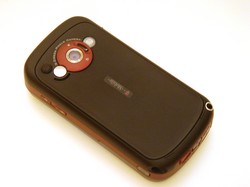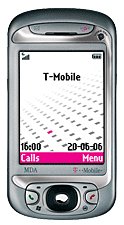I was on a panel at the Radio Academy’s Radio at the Edge seminar yesterday, discussing the future of radio broadcasting, and it was a bit of a hoot. The radio crowd got to listen to us pontificating about podcasting, the Internet and how radio schedules were a thing of the past (my contribution). John Plunkett reported it live on the Guardian blog if you’re interested, but that’s not really what I wanted to talk about. I thought you might like to get my first impressions of the MDA Vario II handset and T-Mobile HSDPA high speed data service combo that I took with me as a demo rig. It’s supposed to be the state of the art in high speed mobile broadband, so is it? To find out read on…
As part of my 5 minutes of fame on stage I wanted to demonstrate the power of the Internet to change the radio landscape, and what better way thought I, than to demo a brand spanking new HSDPA handset running high speed, high quality net radio at broadband speeds. The good folk at T-Mobile kindly obliged by lending me a swish new MDA Vario II handset and off I went, having acquainted myself with the unfamiliar Microsoft Mobile 5.0 O/S the night before, and bookmarked a cool live Inuit radio station to play as my proof point.
Well, you’ve guessed it. The seminar was in the deepest basement of the venue with no signal at all, and I discovered the WiFi connection far too late to use it, so I was reduced to waving the handset threateningly in the air to scare the attendees into agreeing with my proposal that in future all radio would be sent to mobile phones via high speed IP services. Anyway, that failure apart, here’s my quick opinion of the handset and its new high speed data capabilities (above ground at least).
Point 1. HSDPA works. After a fashion. When you grab the connection it’s fast OK, at times it’s almost as fast as WiFi in fact. But not nearly as reliable. Both at the venue, and in the cab back home afterwards I kept losing signal and getting timeouts for no real reason. The upshot was that you were never quite sure when browsing whether a page would appear after you clicked on a link. It would be click….pause…then load or more pause. A page would take about 5 or 6 seconds to load usually, which is not bad for graphics and text. But overall it was a bit frustrating, great when it worked fast, but untrustworthy. [Aside – here’s a bit of recursive 21st net for you. There I was travelling home in a cab, reading John’s live Guardian blog report of a seminar that I’d just left, as it happened, all courtesy of high speed wireless networking at both ends. Ah what times, what times…!) The point is that we expect our broadband to work flawlessly nowadays, whether wireless or wired, so the mobile providers need to sort this out and make it work, otherwise it’s not going to impress anyone. And remember that this was smack in the centre of London, goodness knows what it’s like in areas with more patchy rural coverage.
Point 2. The MDA Vario II is OK. The spec is awesome – WiFi (which works nicely, but seemed to make a bit of a meal of connecting first time for some reason), Bluetooth, HSDPA, buckets of RAM, 2.0 megapixel camera, lovely crisp touch-screen and of course all that lovely Microsoft business software thrown in. In use it’s surprisingly small and actually surprisingly usable. The keyboard is tactile enough to let you type properly, although you won’t get anywhere near touch type speeds. But it’s certainly good enough to do short documents, emails and the like. The phone function works intuitively so it’s actually easy to make and receive calls (unlike an early model HTC I-Mate I tested a while back, which was a nightmare). There’s even a great scroll wheel – a la Blackberry – which makes such a difference to browsing and other navigational tasks. And the automatic shift from portrait to landscape screen view when using the keyboard is fab.
The bad news? Well, Windows really does suck on mobile devices, honest it does. It isn’t intuitive, it klunks along with long pauses when loading and unloading, and it’s frustratingly obtuse when it comes to finding your way around basic phone functions. I know a lot of it is down to my inexperience, but even so, it really should be better by now and it isn’t. There’s no comparison between this and Symbian for example. Secondly, battery life still sucks. I hardly used the thing during the course of the day, and yet when I got back home fully 30% of battery life had disappeared. That’s simply naff. Finally, Internet Explorer on a mobile is still rubbish. I had to quickly download Opera to get a decent browse experience.
Conclusion: Well it’s nice to get some indication that high speed data services are at last making their way to the mobile handset. It’s clearly still early days however, and the service providers have their work cut out if they’re going to supply fast, robust and dependable broadband to those of us who will use it a lot, for entertainment and business. Oh and the camera? It’s OK. Nothing amazing, nor is it naff.







